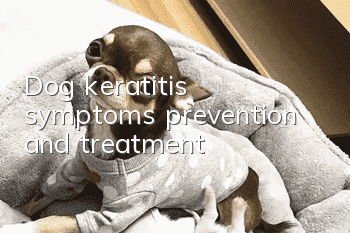Dog keratitis symptoms, prevention and treatment

Keratitis is a general term for inflammation of the corneal tissue. It is characterized by corneal opacity, corneal vegetations, corneal ulcers, corneal perforation and corneal plaques. It can occur in all kinds of dogs, but it is more common in long-haired small dogs. The etiology and treatment effects of 68 cases of dogs diagnosed and treated since May 2005 were analyzed. Most of them were caused by trauma, foreign bodies, inappropriate drugs, and infection, and some of the causes were unknown. After treatment, 66 cases were cured, with a cure rate of 97.06%. Corneal ulcers cause perforations that are difficult to heal. So what are the common symptoms of dog keratitis? And how to treat it?
Miniature Schnauzer
Dog keratitis symptoms:
Traumatic keratitis, traces of trauma can be seen on the surface of the cornea, and the injured area is rough and uneven. Corneal epithelial damage and secondary infection may cause local white bulges - corneal infiltration. When the cornea forms an ulcer, it may cause tears and blurred vision. Or blepharospasm, the cornea appears light yellow or pure yellow turbidity. When large-area ulcers occur, corneal leukoplakia can be seen and even cause corneal fistulas.
Keratitis caused by inflammatory stimulation often presents with corneal opacity. When the cornea is perforated, the aqueous humor surges out, and the iris can be rushed to the wound, causing partial prolapse of the iris, adhesion between the iris and the cornea, and miosis.
Treatment methods for dog keratitis:
1. Based on the principles of eliminating the cause of the disease, reducing inflammation and pain, and promoting absorption, a method that combines local treatment with systemic treatment.
2. Rinse the eyes with saline to remove foreign matter and secretions in the eyes.
3. In the acute phase, when the cornea has not yet developed suppuration, ulceration, or perforation, use chloramphenicol eye drops and cortisone acetate eye drops alternately, 3 to 5 times a day. At the same time, systemic treatment is carried out, with ampicillin sodium injection, compound aminopyrine injection, and dexamethasone sodium phosphate injection intramuscularly or subcutaneously, 1 to 2 times a day, for 2 to 7 days.
4. For viral keratitis, polymyosin injection or immune serum should be used at the same time, depending on the situation, every day or once every day for 3 to 5 days.
5. In addition, symptomatic treatment should also be carried out. If necessary, intravenous infusion of 5% glucose saline can improve systemic symptoms and improve the animal's resistance.
6. If keratitis is secondary to bacterial infection, suppuration, ulceration, or even perforation occurs, use 80,000 units of penicillin mixed with 0.5 ml of normal saline and then instilled into the eyes, 3 to 5 times a day, and systemic treatment at the same time.
7. If the corneal perforation is severe, palpebral conjunctiva covering surgery can be performed to make an autologous eye bandage for the affected eye, which can effectively prevent the continued leakage of atrial fluid and prevent the invasion of pathogenic microorganisms, which is beneficial toRepair of corneal damage. If combined with inosine, vitamin C, vitamin B1, and vitamin B2, the effect will be better.
8. Strengthen the care of sick dogs, minimize their outdoor activities, avoid strong light stimulation and dust falling into their eyes, avoid fighting with other dogs and injuring their sick eyes, and feed them nutritious and easy-to-digest food.
- How to tell if your dog has bladder stones? A must-read for novices!
- What causes dogs to have double rows of teeth?
- How to train a Teddy dog that is not obedient? Here are some tips for you!
- What to do if your dog has a bloated stomach?
- Symptoms and treatment of balanitis in dogs
- What causes dry hair in dogs
- How to train a golden retriever
- Can newborn puppies drink soy milk?
- What should you do if your dog likes to bite?
- Three secrets of longevity for a 240-year-old dog



